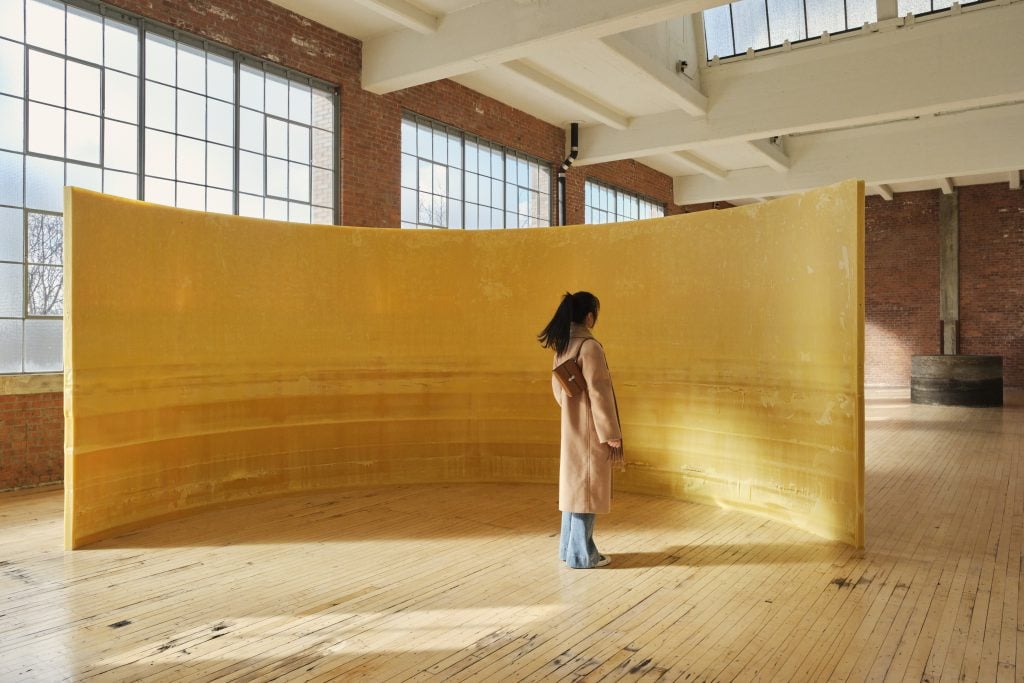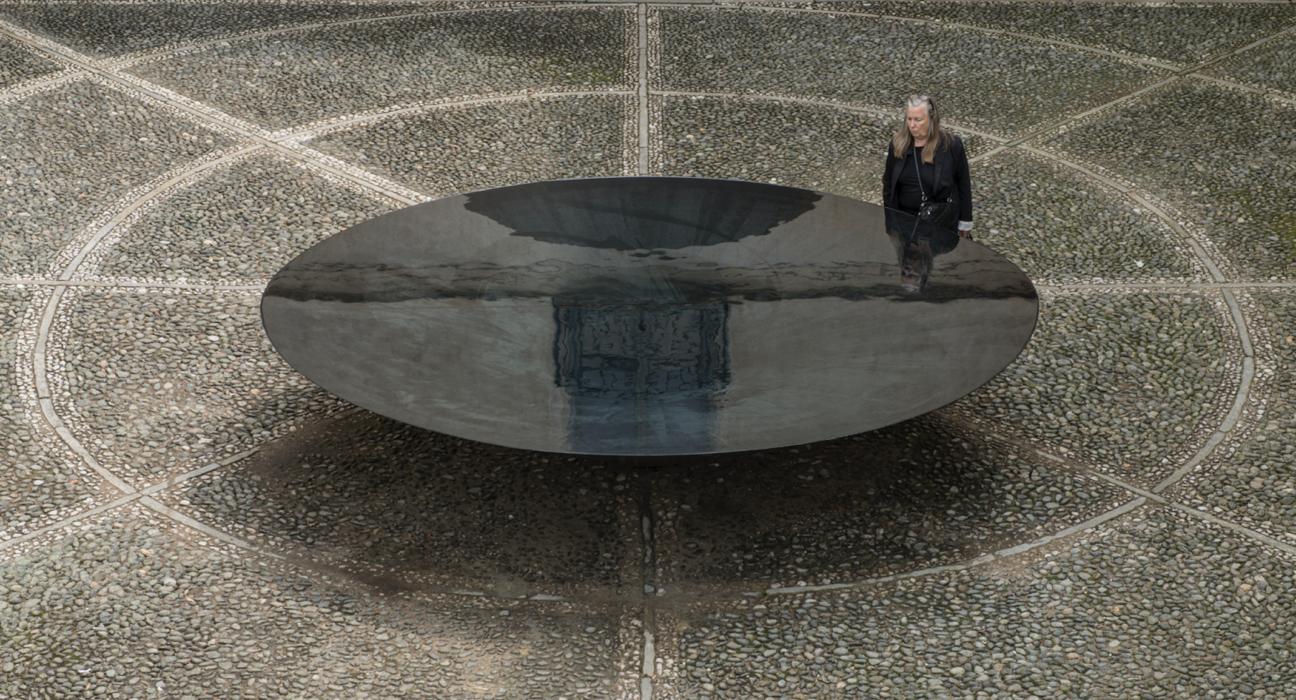Meg Webster has spent the last 40 years making sculptures and installations that respond to the beauty of living earthen materials as a way to celebrate the environment, a practice that is only now winning her due recognition. In a recent interview, she told me she defined herself as “a sculptor who makes minimal art with natural materials, meant to be perceived directly by the body, and sometimes entered.”
The architectonic structures of land art, and the formal rigor of Minimalism before it, were significant influences on Webster’s sculpture. But her immersive earth works took a different direction from the grandiose—and ecologically questionable—outdoor interventions pioneered by the likes of Michael Heizer, her former mentor. Through time, Webster has brought her work more and more indoors, focusing on creating sculptures that bring nature into the gallery.
Born in 1944, Webster completed her MFA at Yale in 1983, studying with Donald Judd and Richard Serra, two giants of Minimalism. “I learned from them the idea of the power object,” she said. Her Wall of Beeswax (1990), an eight-foot-high curved barrier, is like one of Serra’s signature steel plates made soft and tactile. While his work rusts and weathers in the elements, the layered beeswax wall brought indoors retains its luscious golden color with a sweet scent as you follow its curves. “I first made this in L.A. for the Regen Gallery, intended as a material form to get close to, smell, and enjoy the color,” Webster explained.

Meg Webster, Wall of Beeswax (1990). Meg Webster, installation view, Dia Beacon, New York, 2024. © Meg Webster. Photo: Don Stahl. Courtesy Dia Art Foundation.
Her sensitive, sensuous work was initially created as a reaction to the politics and anxieties of the time, namely the heightened Cold War arms race. “I first made works in the early 1980s in response to the scary place we were in” she said. “My idea was to reference natural shapes and materials, and in some cases make something with raw natural material to be entered into.”
Wall of Beeswax is among nine sculptures by Webster now on view at the Dia Art Foundation in Beacon, New York—the artist’s largest presentation to date. The display follows her inclusion last year in Groundswell: Women of Land Art, a major survey exhibition at the Nasher Sculpture Center in Dallas that overhauled the male-dominated narratives of the land art movement.
The Dia presentation, curated by Matilde Guidelli-Guidi with the curatorial assistant Liv Cuniberti, takes a focused look at Webster’s works between 1986 and 1990. Guidelli-Guidi described this as “a pivotal period in Webster’s oeuvre, when the artist defined her distinct sculptural method and vocabulary of negative and positive volumes, containers, and enclosures.”
Meg Webster, Stick Spiral (1986). Meg Webster, installation view, Dia Beacon, New York, 2024. © Meg Webster. Photo: Don Stahl. Courtesy Dia Art Foundation.
The sculptures run the 285-foot length of a large gallery at Dia with a view of John Chamberlain’s crushed automobile parts in the gardens outside. The juxtaposition of soft organic material and hard steel offers a striking contrast. Stick Spiral (1986), 20 feet in diameter, is a curl of flowering branches and twigs, tied and trailing like Rapunzel’s hair. One can move along the flowing form until you reach the innermost circle. “This, too, is a work I made to be entered,” Webster said.
Moss Bed, King (1986) layers verdant moss over a low platform with the dimensions of a king-size mattress. One has the urge to lounge upon its soft contours of green. Cono di Sale (Cone of Salt) is a six-foot-tall cone made entirely of salt crystals. First created in 1988 for the Venice Biennale, it was “a primary form of primary material,” Webster said. Her works are remade anew every time they are installed, she noted, with all the materials sourced locally.
Meg Webster, Moss Bed, King (1986). Courtesy the artist and Paula Cooper Gallery, New York. © Meg Webster. Photo: Bill Jacobson Studio, New York. Courtesy Dia Art Foundation.
Mound is made of yellow clay that has been raked and walked on to form a precise shallow dome. Its curvier counterpart in deep red clay, also tamped down with hands and feet, is called Mother Mound, which Webster likens to a pregnant belly. These seemingly perfect geometric shapes created out of loose natural elements “defy material expectations and provoke a heightened awareness of the natural world,” Guidelli-Guidi said.
The process is exacting. All Webster’s works are “instruction-based,” Guidelli-Guidi said, and this selection was realized on site over a six-week period by “repeatedly packing, pouring, ramming, or interweaving a loose material: salt, wax, soil, or sticks.” Remarkably, no binding agents are used, although Webster relies on implements and sometimes molds to “perfect the contour of the sculptures.”
Recreating these early works at Dia, three to four decades after their original making, presented “an opportunity to study the work anew as I rework the material,” Webster said. As pristine as the pieces appear to a visitor’s eye, she allows for their natural evolution. “The weathering, cracking, and shrinking are a part of the raw materials changing with time.”
Meg Webster, installation view, Dia Beacon, New York. © Meg Webster. Photo: Bill Jacobson Studio, New York. Courtesy Dia Art Foundation.
Five of the nine pieces on show belong to the permanent collection at Dia, which has made strides in recent years in advancing the representation of women and people of color in its pantheon of Minimalism, conceptualism, and land art. The Webster exhibit will remain on view for two or more years, in keeping with Dia’s practice of longer-term installations.
Webster’s indoor pieces are represented in many museum collections, including the Whitney, the Walker Art Center, the Guggenheim, and the Dallas Museum of Art. She has also created ambitious outdoor installations such as the 70-foot-diameter earth work, Concave Room for Bees, at Socrates Sculpture Park in Queens in 2016–17. It was a functioning ecosystem as well as an interactive sculpture, thriving with flowers and plants that attracted insects. Webster’s work breathes life.
Now aged 80, the artist said her “desire to keep going comes from my desire to care for the planet, its creatures, for ecological balance, my love for materials of the earth, the plants, and to understand systems of inhabitation in order to further these ecological systems.”
Meg Webster at Dia Beacon, 2024. Photo: Don Stahl, courtesy of Dia Art Foundation.
“Meg is a most generous and acute thinker with a deep-set commitment to ecological justice,” Guidelli-Guidi said, describing her as “part engineer and part gardener.” Walking into Dia and seeing Webster’s earthen materials in graceful arcs and mounds is indeed a reminder of how precious, beautiful, and life-giving nature is.
Follow Artnet News on Facebook:

